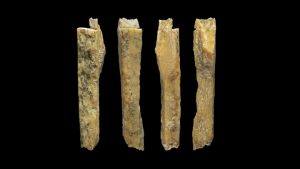Ed Yong in The Atlantic:
 In 2014, two archaeologists, Katerina Douka and Tom Higham, paid a visit to Denisova Cave—a site high up in Siberia’s Altai Mountains that has become something of a magnet for scientists interested in humanity’s past. A decade ago, researchers found a pinky bone in the cave. After analyzing its DNA, they realized it represented a previously unknown group of ancient humans, distinct from either Neanderthals or Homo sapiens. That group became known as the Denisovans.
In 2014, two archaeologists, Katerina Douka and Tom Higham, paid a visit to Denisova Cave—a site high up in Siberia’s Altai Mountains that has become something of a magnet for scientists interested in humanity’s past. A decade ago, researchers found a pinky bone in the cave. After analyzing its DNA, they realized it represented a previously unknown group of ancient humans, distinct from either Neanderthals or Homo sapiens. That group became known as the Denisovans.
Three Denisovan teeth have been found in the same place since, along with the toe of a Neanderthal. But such recognizable bones are a rarity. When Douka and Higham visited the cave, they realized that the vast majority of bones recovered from it are tiny, unidentifiable slivers. It’s impossible to tell which body part they came from, let alone which species. Roughly 5 percent of them can be narrowed down to a specific class of animals—a mammal, perhaps, but nothing more precise. “They’re dug up, washed, and put in a bag, never to be seen again,” Douka says.
If analyzed, the DNA within these fragments could easily reveal the identity of their owner. But the fragments are manifold, and sequencing DNA is still laborious and expensive. It would be too costly to inspect every single sliver. So instead, Douka and Higham turned to a new technique that’s much faster and cheaper.
More here.
